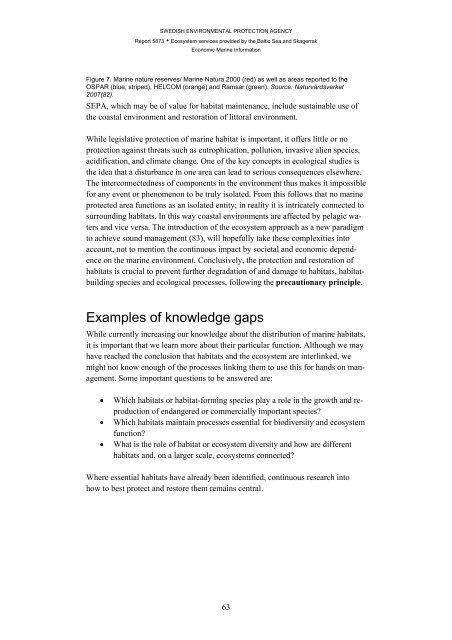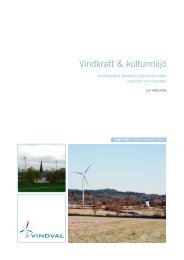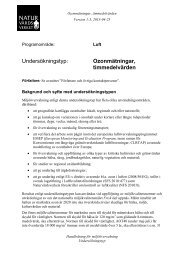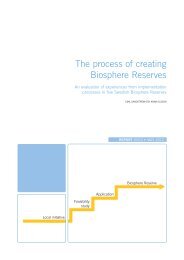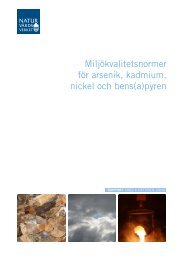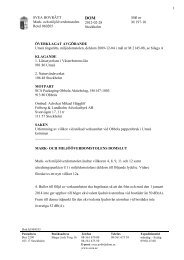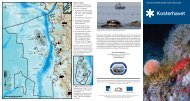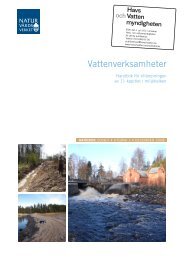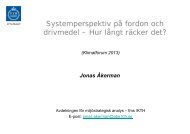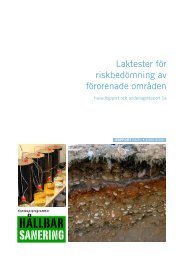Ecosystem services provided by the Baltic Sea ... - Naturvårdsverket
Ecosystem services provided by the Baltic Sea ... - Naturvårdsverket
Ecosystem services provided by the Baltic Sea ... - Naturvårdsverket
Create successful ePaper yourself
Turn your PDF publications into a flip-book with our unique Google optimized e-Paper software.
SWEDISH ENVIRONMENTAL PROTECTION AGENCY<br />
Report 5873 • <strong>Ecosystem</strong> <strong>services</strong> <strong>provided</strong> <strong>by</strong> <strong>the</strong> <strong>Baltic</strong> <strong>Sea</strong> and Skagerrak<br />
Economic Marine Information<br />
Figure 7. Marine nature reserves/ Marine Natura 2000 (red) as well as areas reported to <strong>the</strong><br />
OSPAR (blue, striped), HELCOM (orange) and Ramsar (green). Source: <strong>Naturvårdsverket</strong><br />
2007(82).<br />
SEPA, which may be of value for habitat maintenance, include sustainable use of<br />
<strong>the</strong> coastal environment and restoration of littoral environment.<br />
While legislative protection of marine habitat is important, it offers little or no<br />
protection against threats such as eutrophication, pollution, invasive alien species,<br />
acidification, and climate change. One of <strong>the</strong> key concepts in ecological studies is<br />
<strong>the</strong> idea that a disturbance in one area can lead to serious consequences elsewhere.<br />
The interconnectedness of components in <strong>the</strong> environment thus makes it impossible<br />
for any event or phenomenon to be truly isolated. From this follows that no marine<br />
protected area functions as an isolated entity; in reality it is intricately connected to<br />
surrounding habitats. In this way coastal environments are affected <strong>by</strong> pelagic waters<br />
and vice versa. The introduction of <strong>the</strong> ecosystem approach as a new paradigm<br />
to achieve sound management (83), will hopefully take <strong>the</strong>se complexities into<br />
account, not to mention <strong>the</strong> continuous impact <strong>by</strong> societal and economic dependence<br />
on <strong>the</strong> marine environment. Conclusively, <strong>the</strong> protection and restoration of<br />
habitats is crucial to prevent fur<strong>the</strong>r degradation of and damage to habitats, habitatbuilding<br />
species and ecological processes, following <strong>the</strong> precautionary principle.<br />
Examples of knowledge gaps<br />
While currently increasing our knowledge about <strong>the</strong> distribution of marine habitats,<br />
it is important that we learn more about <strong>the</strong>ir particular function. Although we may<br />
have reached <strong>the</strong> conclusion that habitats and <strong>the</strong> ecosystem are interlinked, we<br />
might not know enough of <strong>the</strong> processes linking <strong>the</strong>m to use this for hands on management.<br />
Some important questions to be answered are:<br />
<br />
<br />
<br />
Which habitats or habitat-forming species play a role in <strong>the</strong> growth and reproduction<br />
of endangered or commercially important species?<br />
Which habitats maintain processes essential for biodiversity and ecosystem<br />
function?<br />
What is <strong>the</strong> role of habitat or ecosystem diversity and how are different<br />
habitats and, on a larger scale, ecosystems connected?<br />
Where essential habitats have already been identified, continuous research into<br />
how to best protect and restore <strong>the</strong>m remains central.<br />
63


